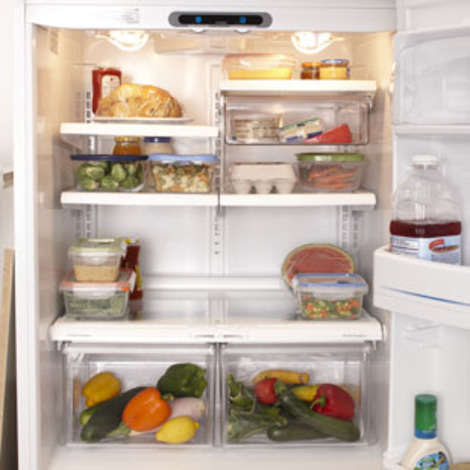Give Your Fridge Some Love! 6 Trouble Spots to Target

By Gretel H. Schueller, Contributing Writer for EatingWell
Think you know it all when it comes to the hardest-working appliance in your kitchen? Exposed to spills, smells and overloading, fridges don't often get much appreciation. Most Americans only clean their refrigerators once or twice a year. Yet a clean, organized fridge helps keep food fresh for longer, reduces food waste and minimizes the threat of food contamination. Take a few minutes to spring clean your fridge this month and make sure to address these 6 trouble spots.
Don't Miss: 5 Risky Refrigerator Mistakes You're Probably Making
1. Blast Odors Naturally
The best way to prevent odors is to regularly clean shelves and to store leftovers in airtight containers. In fact, food should always be covered to keep it from drying out and absorbing odors. To clean and fight smells in one go: Wipe the fridge interior with a mix of 2 tablespoons baking soda and 1 quart hot water. Rinse with a damp cloth, then dry with a clean towel. To keep a lid on odors, place a dish of baking soda in your fridge and replace it about once a month. For those extra-pungent smells, drip some vanilla extract on a cotton ball or small, dry sponge and place it in the fridge.
2. Target the Germiest Spots
Multiple studies confirm that produce drawers host more life than a New York City subway during rush hour. "It's an area we don't always think about. But we use it often and store raw, unwashed veggies together with prewashed ones," notes Lisa Yakas, a microbiologist with NSF International, a nonprofit public-health organization "Dark, moist environments breed germs, even in the fridge." Of the 14 areas tested in multiple kitchens, the 2013 NSF kitchen study found the produce compartment topped the list for most microbes, with yeast, mold,Salmonella and Listeria. Other germy winners included the water dispenser and the meat compartment. A study by Microban Europe (a company that develops antibacterial technology) also found the produce drawer to be the microbial hot spot--and included notorious E. coli 0157. When Tennessee State University microbiologists swabbed 137 household refrigerators, they found more than 23 percent were home to Klebsiella pneumoniae, which causes respiratory infections. But no need to get all Howard Hughes. Wash the drawers weekly with dish soap under warm, running water, says Yakas. Dry them completely with a clean towel before reinserting. Ensuring your fridge stays at 40 degrees F or cooler is another effective way to reduce foodborne illness. Yakas recommends keeping produce packaged separately.
3. Reorganize Your Produce Drawers
Produce that gives off ethylene, such as apples, avocados, mangoes, tomatoes and peaches--should not be stored next to ethylene-sensitive ones like broccoli, carrots and leafy greens. Ethylene-producing foods speed up the ripening (and decay) process of their neighbors. While tomatoes last longer in the fridge, cold can make them mealy, particularly if they are not completely ripe. If there's no danger of them going bad, keep your ethylene-producing fruit in a bowl, out of the fridge. Also, there's no clear evidence that those "green" bags marketed to keep produce fresh longer work.
Don't Miss: 14 Fruits and Vegetables You Should Buy Organic
4. Move Your Milk
One of the top causes of foodborne illness is cross-contamination. The golden rule of fridge hygiene: always store meats on the bottom shelf. It's the coldest part of your fridge and meats on the top shelf can drip onto other foods. And while the door seems to be a perfect fit for a milk carton, it's the warmest part of a fridge--so not a good place for dairy or eggs. Only condiments and other items that don't perish quickly should be on the door. For good measure, place a rimmed plate under any item likely to leak, from meat to berries.
5. Check Your Moldy Cheese
Is there moldy cheese hiding out in your deli drawer? If the ick-factor doesn't bother you, simply cut off the moldy bit of cheese. However, if the cheese is covered, say goodbye. (It's difficult for mold to penetrate dense foods; that's why hard cheeses are safe. This rule of thumb doesn't apply to all foods, however.) If your leftovers regularly turn into science experiments, consider labeling containers with dates and using glass so you can easily see what's inside. Most leftovers have a shelf life of three to five days, so do a weekly food inventory.
Related: 4 Moldy Food You Can Actually Eat (and 8 You Should Definitely Toss)
6. Toss Old Food
Most leftovers have a shelf life of three to five days, so do a weekly food inventory. If your leftovers regularly turn into science experiments, consider labeling containers with dates and using glass so you can easily see what's inside. As for packaged food products, there is no standard system used for food dating in the United States. Except for baby foods, freshness dating is voluntary; stores are not required to remove outdated products from their shelves. "Use-by" dates refer to quality, not safety. But an expiration date means what it says. If you haven't used it by this date, toss it. Buy eggs before the "sell-by" date and use within 3 to 5 weeks of when you buy them. The "sell-by" date will usually expire, but the eggs are safe. Typically, condiments that have a higher sugar and salt content have a longer fridge life. Ketchup and mustard: up to 6 months; mayo: 2 months.
Don't Miss: 5 Foods You Shouldn't Keep in Your Fridge
By Gretel H. Schueller
Gretel H. Schueller is an award-winning journalist and book author. A graduate of New York University's Science, Health and Environmental Reporting Program, she's put her masters in journalism to good use. While on assignment, she has eaten backyard weeds, harvested cactus buds in an Arizona desert and made goat cheese in Greece.
Related Links from EatingWell:
